The Northern Irish Football League is stronger than ever. The professionalisation of the many teams in the league has seen a dramatic increase in the standard. Teams across the UK are now paying close attention to the many talented players emerging from Northern Ireland. Trai Hume, Shayne Lavery, and Connor McMenamin have all made moves from the Irish League in recent years to the EFL Championship and Scottish Premiership.
This trend continues, with several of the league’s top performers already making the move to Scotland this summer, looking to establish themselves at a higher level. This tactical analysis and scout report will provide an analysis of the performances of Ronan Hale, Daniel Finlayson, and Fraser Taylor, highlighting what they will bring to their new sides. We’ll analyse strengths that will allow them to thrive within their new sides’ tactics, and weaknesses that could hinder their progress will be considered.
Ronan Hale (Ross County)
Ronan Hale has had an outstanding two seasons with his hometown club, Cliftonville. The North Belfast native was once on the books of Birmingham City as a teenager and has gone on to have spells with various clubs across Ireland. The 25-year-old was a crucial component of Cliftonville’s title charge and bagged a brace in the Irish Cup final to secure The Reds their first Irish Cup since 1979.
Hale’s greatest strength is his ability to take players on. Hale will often drop deep and look to receive the ball at his feet, enabling him to drive and take on his direct opponent. Hale has a wonderful ability to glide by his opponents, opening up space for both him and his teammates to exploit. He averaged 5.08 dribbles per 90 last season.
The Northern Irish Football League is stronger than ever. The professionalisation of the many teams in the league has seen a dramatic increase in the standard. Trai Hume, Shayne Lavery, and Connor McMenamin have all made moves from the Irish League in recent years to the EFL Championship and Scottish Premiership.
This trend continues, with several of the league’s top performers already making the move to Scotland this summer, looking to establish themselves at a higher level. This scout report will analyse the performances of Ronan Hale, Daniel Finlayson, and Fraser Taylor, highlighting what they will bring to their new sides. Strengths that will allow them to thrive and weaknesses that could hinder their progress will be considered.
Ronan Hale has had an outstanding two seasons with his hometown club, Cliftonville. The North Belfast native was once on the books of Birmingham City as a teenager and has gone on to have spells with various clubs across Ireland. The 25-year-old was a crucial component of Cliftonville’s title charge and bagged a brace in the Irish Cup final to secure The Reds their first Irish Cup since 1979.
Hale’s greatest strength is his ability to take players on. He will often drop deep and look to receive the ball at his feet, enabling him to drive and take on his direct opponent. Hale has a wonderful ability to glide by his opponents, opening up space for both him and his teammates to exploit. He averaged 5.08 dribbles per 90 minutes last season.
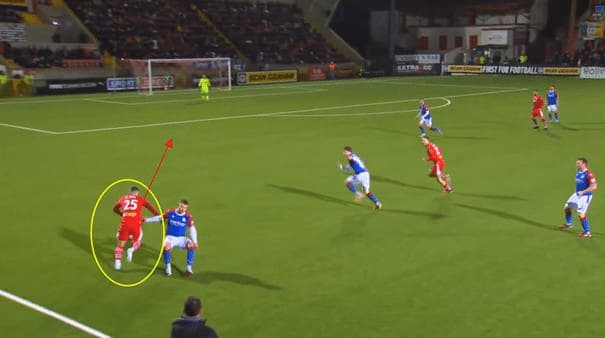
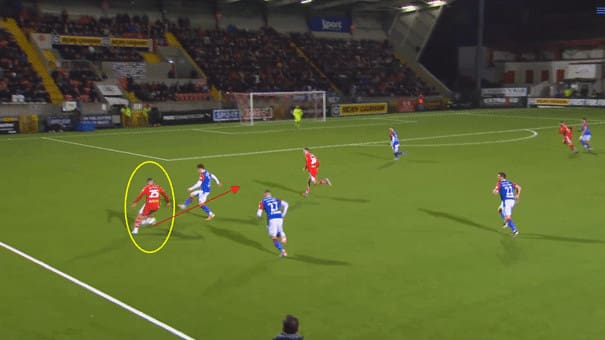
In this example, Hale drives takes the ball past the pressing right back with his first touch as the next defender charges in, Hale nutmegs his opponent before driving forward and playing a pass into the box for his centre forward partner. Hale has completed a remarkable number of penetrating carries, 55 of which were taken into the penalty area. Hale can then capitalise on the chances that he has that has undoubtedly caught the attention of so many.
Hale scored an impressive 21 goals in 31 games across all competitions last year. He had the second-highest average of shots per 90, 4.02 and the 7th most shots from outside the penalty area. His goal return isn’t the only reason he gained so much interest last year, yet the quality of the goals that Hale scored was a constant feature of his game last season. Hale exceeded his expected goals figure of 12.48 in the league scoring 14 goals.
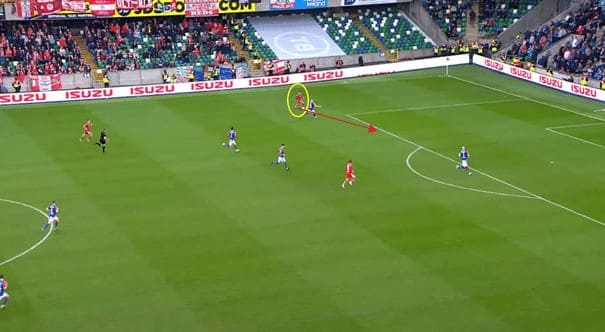
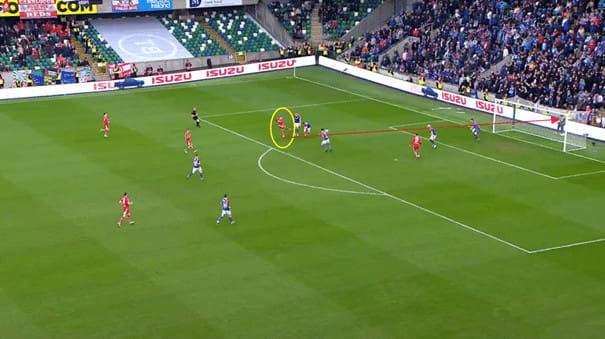
No goal better depicts Hale’s quality than his first goal in extra time in the Irish Cup Final. Hale picks up the ball on the left wing, where he can often be found drifting out. He jinks inside, beating two players before curling the ball into the far top corner.
Out of possession, Hale provides significant help to his side. His speed, paired with his tenacity, allows him to be effective while pressing. Hale was dribbled past only nine times last season and won 2.71 duels per 90 last season in the League.
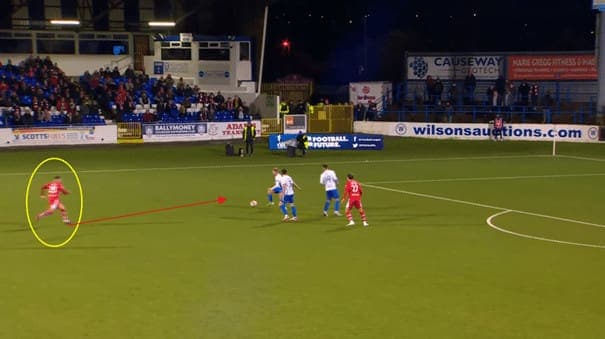
Here, Hale sees an opportunity to win the ball during the defensive transition. After his strike partner fails to win his aerial duel, Hale quickly pounces on the defender who controls the second ball, winning it back in a dangerous area.
Hale is also a considerable threat during the offensive transition. He can often rely on his dribbling during counterattacks to be a threat, yet his movement is also a key factor. When Cliftonville wins the ball back, he is quick to make runs in behind, using his pace to get behind the opposition’s defence.
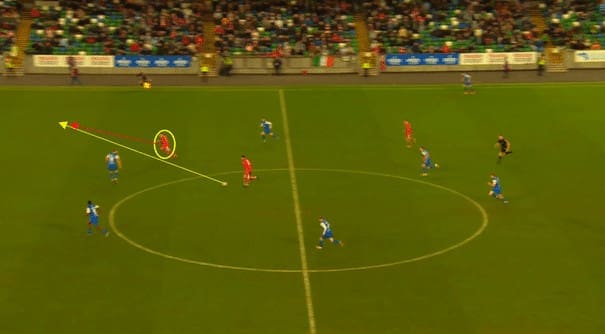
In this example, Hale’s strike partner has just won the ball back after the opposition made a loose pass. As Hale always displays in the offensive transition, his first thought is to go forward. He pulls wide of the centre-back and is slipped through on goal.
Hale had a remarkable campaign and has well and truly earned his move to Scotland. Ross County have given him the number 9 shirt and will hope that he can make the goal contributions that will help the Staggies avoid the relegation battle they found themselves in during past seasons.
Daniel Finlayson (Livingston)
Finlayson joined Linfield in July 2022, initially on loan from his parent club, St Mirren, before making the move permanent in the summer of 2023. The 23-year-old is a product of the Rangers youth academy, yet had failed to establish himself at first-team level in Scotland, unable to make an appearance for Rangers and playing only four times for St Mirren. However, two seasons in Northern Ireland have significantly raised his profile. The right-back was Linfield’s player of the season in the 2022/23 season and earned himself a place in NIFL’s team of the season as well. Another solid campaign has led to Finlayson earning a move to Scottish Championship side Livingston.
The Glasgow-born defender’s biggest strength is his aerial ability. Finlayson won 63.53% of his aerial duels last season, playing at both right back and right centre back in a back three. His quality while defending in the air is highlighted by his making the 8th most headers in his own box during last season’s league campaign.
Not only is Finlayson’s aerial presence a real asset in the box, but his ability to win the ball in the air makes him a threat during attacking set pieces. He had the third-most headed shots in the league last season and scored three goals.
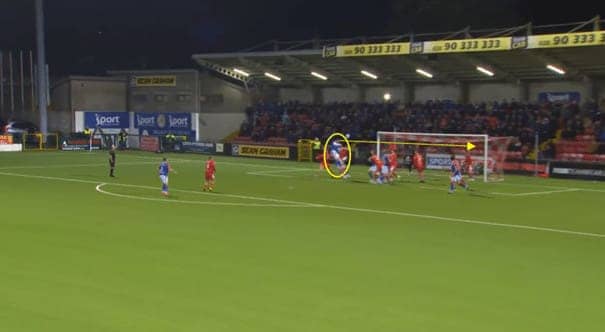
This example shows Finlayson rising above everyone with an incredible leap. He meets the ball firmly with his head, sending the ball past the opposition’s goalkeeper to score what was a vital goal for his side.
Finlayson provides real stability when defending 1v1. Finlayson, often playing as a right centre back in a 3-5-2, was continuously relied upon in 1v1 situations out wide, having to cover for his attack-minded wing backs. He has won 70.53% of his defensive duels, giving him a percentile rank of 88.9 when compared to right-backs in the league last season.
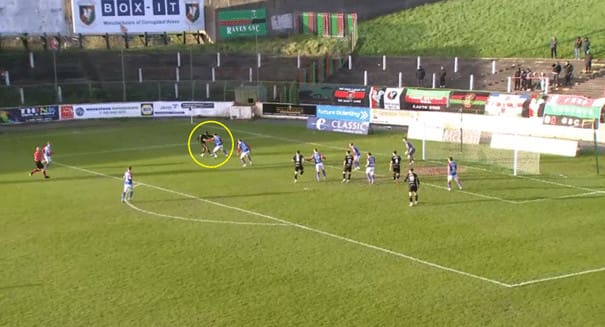
Here, Finlayson is having to defend against an opposition forward travelling at speed towards him in the box. He stands his ground, showing the attacker out wide, and at the right moment, he steps in and wins the ball back.
Finlayson also has the ability to carry the ball out of defence, driving his team forward in the build-up play. This is something that Finlayson excelled at, making 97 progressive runs with the ball last season, the fourth most in the league last season.
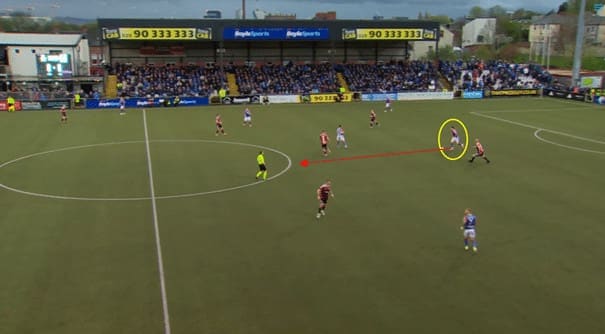
In this example, Finlayson is playing as the central centre back in a back three. He picks up the ball and drives forward, driving past several opponents before passing the ball off to one of Linfield’s attackers.
One area that Finlayson has struggled with is his ability to create chances for his teammates. When compared with other right-backs in the NIFL, he had a percentile rank of only 25.07 for dangerous passes. Right-backs are required to put balls in the box for their teammates to attack, yet Finlayson’s numbers highlight his failings in this area. When he played right back this season, he averaged only 1.88 crosses a match with a completion rate of 28.1%.
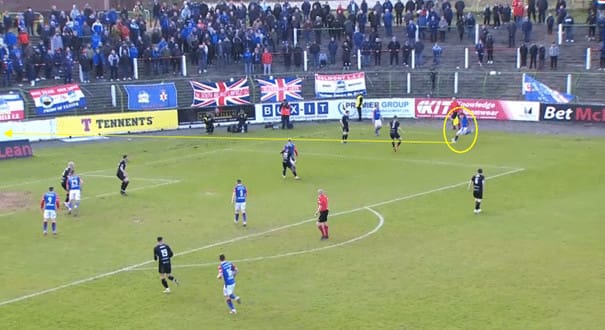
Finlayson has pushed high up the pitch to provide support from under the ball. After receiving a pass, he looks to deliver a cross into the box. However, he overhits the ball, leading to it going out of play.
Finlayson is ready to establish himself in Scotland. Livingston will be hoping to push for promotion in what will be an extremely competitive Scottish Championship this season. Through Finlayson’s aerial ability and reliability when defending 1v1, he could be a real asset to Livingston.
Fraser Taylor (St Mirren)
Fraser Taylor impressed in his first full season of first-team football. The 21-year-old from Johnstone has come through the St Mirren youth academy and is already making a couple of appearances for the first team. Taylor was given a loan move to Ballymena United to provide the midfielder with the experience necessary to thrive. Playing in what was a struggling side, Taylor stood out, putting in countless memorable performances and aiding Ballymena’s great escape from relegation.
Playing as an 8, Taylor proved time and time again his creative abilities. He completed 55 through balls, the fourth most of any player in the league last season. His willingness to play forward is highlighted by him averaging 12.38 forward passes per 90. He had a percentile rank of 82.6 for dangerous passes when compared with midfielders in the league last season.
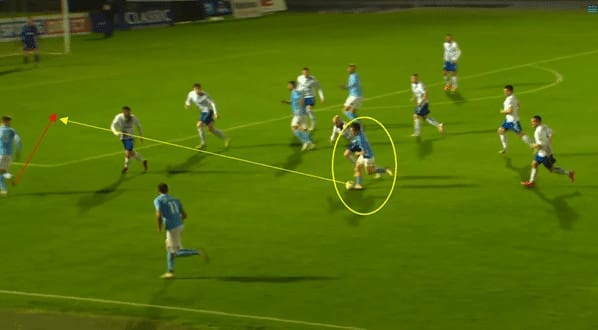
In this example, Taylor plays an excellent ball through the opposition’s backline into the path of a forward runner. Despite Taylor’s desire to play forward, this goes against him at times.
He often forces passes forward, meaning many of his passes aren’t successful. Only 22% of his through balls were successful last season. He also had a percentile rank of 6.9 for pass accuracy when compared with midfielders in the league.
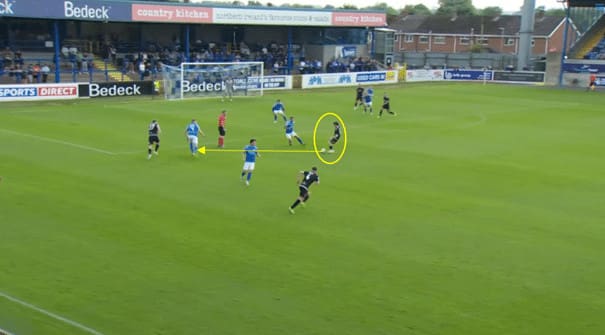
Taylor attempts to play the ball again, in between the opposition’s full back and central defender. However, the opposition have provided adequate cover to prevent the ball from being played through. Instead of playing a simpler pass, Taylor forces the forward pass, giving away possession.
Taylor’s ability to progress play can also be seen in his willingness to drive forward with the ball. He averaged 3.6 dribbles per 90 last year. When compared with midfielders in NIFL, he had a percentile rank of 89.1 for dribbles per 90.
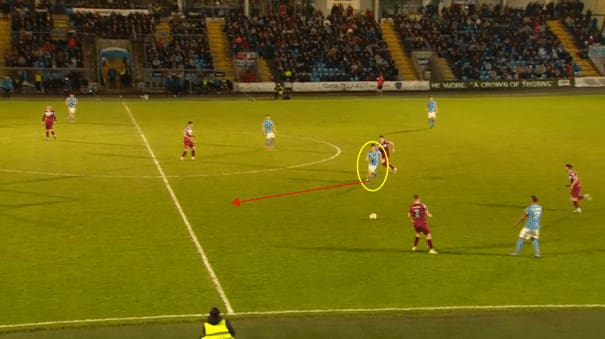
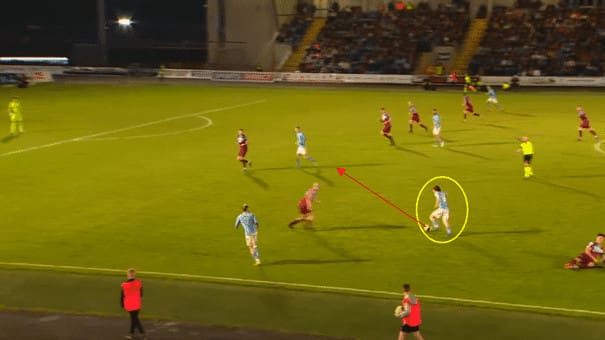
As the ball travels towards Taylor, he is being pressed aggressively from behind. Taylor is quick to take a first touch out of his feet forward, bursting away from the defender. He then drives at the opposition’s defence, going by another opponent, who then fouls Taylor, winning a free kick on the edge of the box.
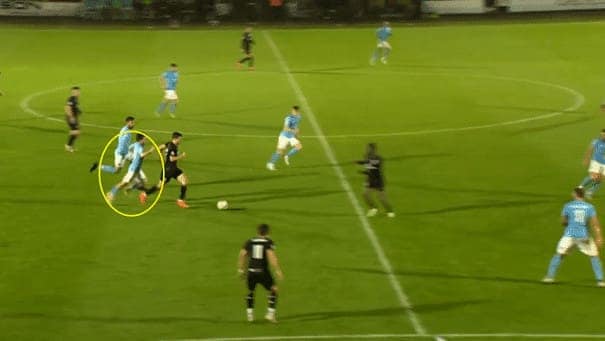
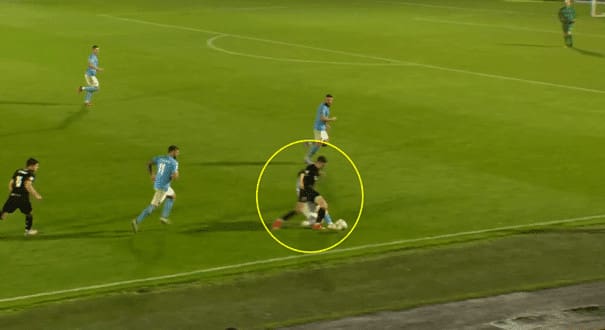
In this situation, Taylor is chasing after an opponent who is driving forward with the ball. Taylor works extremely hard to stay with him before eventually making an excellent slide tackle. However, Taylor does, at times, commit too much when pressing.
Taylor’s tendency to dive in has led to him allowing more progressive passes than any player in the league last year. He also has a percentile rank of only 24.7 for defensive duels won percentage compared to centre midfielders in NIFL.
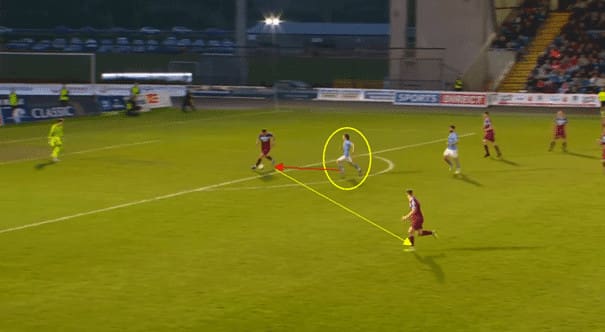
In this example, Taylor breaks from midfield to pressure an opposition centre-back. Although this is commendable and shows a real willingness to press, it leaves his side with one less player in midfield. The opposition plays around him and can progress up the pitch.
Taylor’s step into St Mirren’s first team will be unlikely despite his many outstanding attributes. However, I could see him being a real asset on loan again to a club in the Scottish Championship, where he can further develop, building on his impressive season in Northern Ireland last year.
Conclusion
It’s evident that from highlighting the strengths of these players, NIFL provides an excellent platform for players to thrive and then progress to the next level. All three players have areas of their game that will help them to thrive next season, allowing them to further progress their careers in Scotland.





Comments